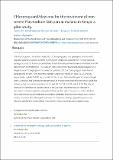| dc.contributor.author | Watkins, W.M. | |
| dc.contributor.author | Brandling-Bennett, A.D. | |
| dc.contributor.author | Nevill, C.G. | |
| dc.contributor.author | Carter, J.Y. | |
| dc.contributor.author | Boriga, D.A. | |
| dc.contributor.author | Howells, R.E. | |
| dc.contributor.author | Koech, D.K. | |
| dc.date.accessioned | 2021-08-31T19:26:21Z | |
| dc.date.available | 2021-08-31T19:26:21Z | |
| dc.date.issued | 5/1/1988 | |
| dc.identifier.citation | Watkins WM, Brandling-Bennett AD, Nevill CG, Carter JY, Boriga DA, Howells RE, Koech DK. Chlorproguanil/dapsone for the treatment of non-severe Plasmodium falciparum malaria in Kenya: a pilot study. Trans R Soc Trop Med Hyg. 1988;82(3):398-403. doi: 10.1016/0035-9203(88)90133-2. PMID: 3068855. | en_US |
| dc.identifier.other | https://doi.org/10.1016/0035-9203(88)90133-2 | |
| dc.identifier.uri | http://repository.amref.org/handle/123456789/191 | |
| dc.description | Restricted | en_US |
| dc.description.abstract | Chlorocycloguanil, the active metabolite of chlorproguanil, was synergistic in vitro with dapsone against 2 culture-adapted Plasmodium falciparum isolates from Kenya; maximal synergy occurred at lower concentrations that it did with pyrimethamine and sulfadoxine. 48 children with asymptomatic P. falciparum infections were treated with chlorproguanil (at a target dose of 1·2 mg/kg) and dapsone (target dose of 1·2 or 2·4 mg/kg); all were free of parasitaemia by day 7. The following numbers had recurrences on days 14, 21, and 28, respectively: 1 of 48, 7 of 47, and 7 of 40. All 39 children treated with pyrimethamine (target dose 1·2 mg/kg) and sulfadoxine (target dose 24 mg/kg) were cleared of infection, while the following had recurrences on days 14, 21, and 28:1 of 39, 2 of 38, and 2 of 36. The rate of decrease in parasitaemia was the same in the 2 groups, and there was no change in haematocrit or haemoglobin during the follow-up. The rate of recurrence in the children receiving chlorporguanil/dapsone was higher, probably because these drugs have a much shorter clearance time than pyrimethamine/sutfadoxine. Chlorproguanil/dapsone is an effective combination for treating P. falciparum malaria and deserves further study. | en_US |
| dc.description.sponsorship | Wellcome Trust | en_US |
| dc.language.iso | en | en_US |
| dc.publisher | Oxford University Press | en_US |
| dc.subject | Metabolite | en_US |
| dc.subject | Kenya | en_US |
| dc.subject | pyrimethamine and sulfadoxine | en_US |
| dc.subject | Parasitaemia | en_US |
| dc.subject | Haemoglobin | en_US |
| dc.subject | Malaria | en_US |
| dc.title | Chlorproguanil/Dapsone for the Treatment of Non-severe Plasmodium Falciparum Malaria in Kenya: a pilot study | en_US |
| dc.type | Article, Journal | en_US |

